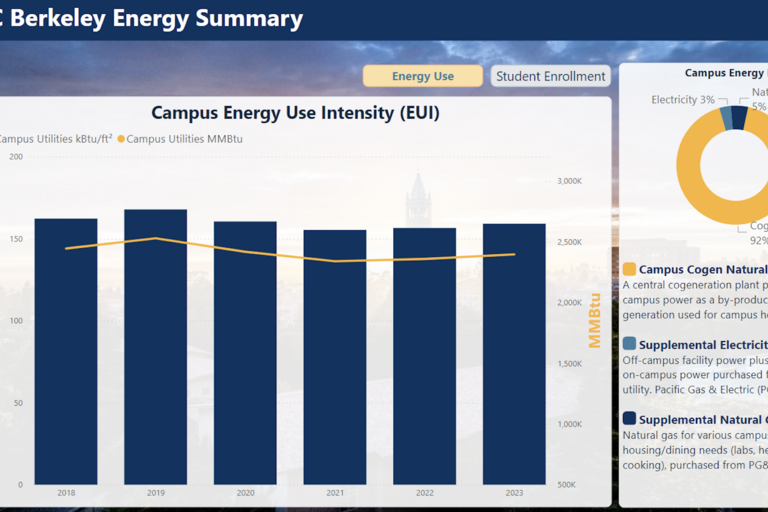The Energy Office tracks, monitors, and manages energy usage campus-wide to reduce energy costs; improve design, performance, and operation of buildings; and provide feedback on energy usage to building occupants. We continuously monitor the operations and maintenance of campus facilities and are in contact with Building Managers regarding their facilities’ operation and utility consumption.
Energy Data and Dashboards
The Energy Office installed building-level meters that track energy use in campus buildings. The Energy & Water Dashboard shows this real-time energy and water use of over 149 campus buildings. The dashboard also provides a visualization of historical energy and water use. We are also using integrated analytics to provide feedback from this data to help identify anomalies and address large system malfunctions.
Clean Energy Campus
Within eight years, Berkeley plans to switch to a new clean and resilient energy system that will phase out fossil fuels and demonstrate cutting-edge technologies and creative financing. For decades, Berkeley has led the world in climate solution technology and policy research. Now, the campus will be powered by an energy system that sets the standard in sustainable, resilient infrastructure. If you want to learn more about this initiative, visit Berkeley Clean Energy Campus
Energy Efficiency Projects
The Energy Office manages and provides input to a variety of energy efficiency projects. Through these projects we strive to make the campus as energy efficient as possible, and meet or exceed the UC system’s goal of 2% reduction in energy use each year. Many of these projects focus on HVAC (Heating, Ventilation, and Air Conditioning) and lighting systems, since these systems are major contributors to energy usage in buildings. However, we also work on many other types of projects such as energy use of labs and IT equipment.
Check out our ULT Freezer Rebate Program case study. This program has saved over 122,500 kWh and $27,000 annually.
Manager of Energy Office: Bruce Chamberlain
Winter Break Curtailment Report!
Each winter break the Energy Office works with the EMS, Stationary Engineers, HVAC and Electric shops to turn down buildings to save energy. Heating and ventilation was curtailed on the Berkeley campus during the period from the end of the business day Friday, December 20, 2024 through Wednesday, January 1, 2025. During the entire curtailment period, faculty and staff were encouraged to plan to be away from campus to allow for effective curtailment of campus facilities.
Reducing energy and steam use during the winter break created cost savings to the campus through energy reductions of 717,065 kWh and 2,308,626 pounds of steam resulting in the equivalent emissions of 220 metric tons of CO2.
Check out the 2024-25 curtailment report for more information here
Energy Policy
UCBs Energy Use Policy, established in 2014, was developed to provide a local framework to support energy-efficient decisions. The policy provides guidance on how UC Berkeley manages its operations so that energy resources are used in the most sustainable manner possible while providing a safe and comfortable environment for teaching, research, and public service. The policy was amended in November 2020 and includes substantial updates to clarify and deepen energy efficiency opportunities in projects and align with Campus Building Department categories. There is also an expanded section on IT virtualization & centralization to improve efficiency and safety of both new and existing server locations. For any questions, please reach out to energyoffice@berkeley.edu
Cooling Request Review for Campus Projects Impacting Utility Use
The Energy Office reviews plans for campus projects that impact utility (energy and water) use. This process encourages efficient design that will not increase building utility use and, if needed, informs VC Administration of the quantified estimate of utility increase. Please note that any proposed project needs to have "no-net increase" per UCB Energy Policy. The review will determine if the proposed project results in no-net increase in the building's metered utility use. For those projects that result in a net increase, offsets will be required to make up for the expected increase. Offsets include energy efficiency and/or water conservation measures or on-site renewable energy generation. If you are a project or building manager working on a project that will impact utility use, please fill out the Cooling Request Form(link is external)
2019 Annual Report
The Energy Office's 2019 Annual Report showcases projects completed in 2019, their savings and impacts, and goals for 2020.
 |
 |
 |
|
|
| Bruce Chamberlain | Ahmed Hassani | Kume Wolde | Amelia Wardle Stacey | |
| Energy Manager | Energy Engineer | Energy Engineer | Energy Office Intern |
Other Resources
- UCOP Energy & Facilities Management Services
- Research at Berkeley on Energy, Climate & Environment
- California Energy Commission Building Energy Efficiency Standards
- UC Berkeley and US Department of Energy Better Buildings
- I2SL (International Institute for Sustainable Laboratories) Northern CA Chapter
- UC Berkeley Sustainability and Carbon Solutions





